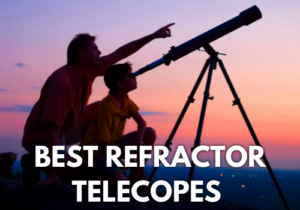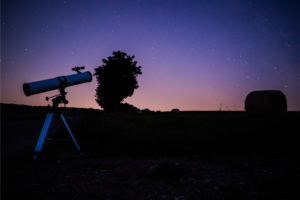
Best Refractor Telescope For Beginners; Reviews
Disclosure: This post contains affiliate links and I may earn a small commission (at no extra cost to you) if you click through and make a purchase. Thanks in advance – I really appreciate it!
Here in this “Best Refractor Telescope For Beginners” article we’ve rounded up 11 of the top refracting telescopes of various types, specifications, and budget best suited for amateur astronomers. Below, you’ll find in-depth reviews of each, as well as an elaborate guide.
COMPARISON TABLE
| Image | Title | Best For | Features | Price | Buy |
|---|---|---|---|---|---|
Top Top
Top
Top
Top Top
Top
Top
Top | Celestron - AstroMaster 70AZ | Best Overall | Type:Refractor, Aperture: 70mm (2.8″), Focal length: 900mm, Focal Ratio: f/13 | See on Amazon | |
 Top
Top
Top
Top Top
Top
Top
Top | SOLOMARK Telescope 80EQ | Best For Smartphone | Type: Refractor, Aperture: 80mm (3.14″), Focal length: 700mm | See on Amazon | |
 Top
Top
Top
Top Top
Top
Top
Top | Celestron - PowerSeeker 80EQ | Best With EQ Mount | Aperture: 80 mm (3.15″), Focal length: 900mm, Focal Ratio: f/11 | See on Amazon | |
 Top
Top
Top
Top Top
Top
Top
Top | Stilnend Telescope 70mm | Best For Kids | Type: Refractor Aperture: 70mm (2.75″) Focal length: 500mm | See on Amazon | |
 Top
Top
Top
Top Top
Top
Top
Top | Gskyer Telescope | Best With ALt-Az Mount | Aperture:90mm(3.5”), Focal length: 600mm, Focal Ratio: f/6.7 | See on Amazon | |
 Top
Top
Top
Top Top
Top
Top
Top | Celestron - AstroMaster 102AZ | Best 4-inch | Aperture: 102mm (4″), Focal length: 660mm, Focal Ratio: f/6.5 | See on Amazon | |
 Top
Top
Top
Top Top
Top
Top
Top | Gskyer Telescope, 70mm | Best For Android | Type: Refractor, Aperture: 70mm (2.75″), Focal length: 400mm, Focal Ratio: f/5.7 | See on Amazon | |
 Top
Top
Top
Top Top
Top
Top
Top | Celestron - 70mm Travel Scope DX | Best Portable | Aperture: 70mm (2.8″), Focal length: 400mm, Focal Ratio: f/5.7 | See on Amazon | |
 Top
Top
Top
Top Top
Top
Top
Top | HUTACT Telescope HD | Best For Moon | Type: Refractor, Aperture: 70mm (2.75″), Focal length: 400mm | See on Amazon | |
 Top
Top
Top
Top Top
Top
Top
Top | Orion GoScope III 70mm | Best For Travel | Type: Refractor, Aperture: 70mm(2.75″), Focal length: 400mm, Focal Ratio: f/5.7 | See on Amazon | |
 Top
Top
Top
Top Top
Top
Top
Top | Celestron - AstroMaster 90AZ | Best For Amateurs | Aperture: 90mm (3.54″), Focal length: 1000 mm, Focal Ratio: f/11 | See on Amazon |
Product prices and availability are accurate as of the date/time indicated and are subject to change. Any price and availability information displayed on [relevant Amazon Site(s), as applicable] at the time of purchase will apply to the purchase of this product.
Prices pulled from the Amazon Product Advertising API on:Refractors are what most people think of when they picture a telescope, having a glass objective lens at the front and the focuser and eyepiece at the rear. However, refractors come in many shapes and sizes with different types of glass and different supplied mountings. They can be optimized for lunar/planetary, deep-sky, or astrophotography use.
A refractor (also called a refracting telescope) is an optical telescope that uses a system of lenses to collect light and form an image.
The refractor, invented in the 17th century, is the earliest type of optical telescope. And nowadays it is still one of the most popular telescope designs in the world, used by both beginners and professionals.

Best Refractor Telescope For Beginners
With so many models and characteristics any modern telescope has, it becomes rather hard for amateurs and beginners to find the one We have analyzed the features that make the best refractor telescope for beginners to help you pick out the one that is most suited to you.
Best Overall
Celestron – AstroMaster 70AZ
- Type:Refractor
- Aperture: 70mm (2.8″)
- Focal length: 900mm
- Focal Ratio: f/13
- Mount: Alt-Azimuth
- Eyepiece: 20mm,10mm
- Magnification: 45x, 90x
- Weight: 11.0 lbs (5.0 kg)
- Our Rating: 9.2/10
Prices pulled from the Amazon Product Advertising API on:
Product prices and availability are accurate as of the date/time indicated and are subject to change. Any price and availability information displayed on [relevant Amazon Site(s), as applicable] at the time of purchase will apply to the purchase of this product.
With 70mm aperture and mounted on an altazimuth mount. It’s an entry level telescope that has several nice features that make it a great option for the beginner astronomer.
The AstroMaster 70 is a 70mm f/12 achromatic refractor, using a standard Fraunhofer configuration with crown and flint glasses for the objective lens. The long focal ratio means that there is not much chromatic aberration (false color).
Its medium aperture and long focal length allow it to draw in a generous amount of light with a high magnification potential to allow observation of the larger planets and the moon.
The included 90° diagonal has an integrated erecting prism that corrects the view to enable the scope’s use on land. Celestron includes two eyepieces for high and medium magnifications.
The Astromaster 70 AZ comes with two eyepieces (20 mm and 10 mm respectively) and a StarPointer Finderscope.
One of the best features of the Celestron 21061 AstroMaster 70 AZ Telescope is that the StarPointer is permanently fixed right next to the eyepiece. Moreover, it uses the red dot technology for lining up a celestial object, a feature you can find on more advanced and expensive telescopes.
The AstroMaster 70 has a 1.25” rack and pinion focuser which is mostly plastic. It works well.
The red-dot finder is attached to the left side of the focuser and is more than adequate for a small scope such as a 70mm refractor.
The telescope makes it possible to view the moon, stars, planets and nebulae, and on very clear nights, it can even allow a user to catch sight of the moons of Jupiter and the rings of Saturn.
The telescope has multi-coated optics that minimize the breakdown of light as it passes through the telescope, ensuring that images are bright and clear.
The AstroMaster is outfitted with a manual alt-azimuth mount and to make finding and tracking objects easy, there is an altitude control handle and an azimuth lock. Supporting the mount and optical tube is a stainless-steel tripod with sturdy 1.25″ diameter legs.
The scope can magnify objects by up to 165 times their size, and has a convenient accessory tray.
With the telescope, you receive access to a database that includes 10,000 celestial objects.
This allows children to learn more about what they’re seeing in the night sky, and to find out what objects to look for during stargazing sessions on any particular night of the year.
Pros:
- Great value for money
- Comes with fully coated professional lenses
- Can also be used for terrestrial viewing
- Perfect for beginners and kids
- Requires no tool to setup
- Easy to use
Cons:
- Sensitive to heat
- Mount is small, a bit short for an average adult
Best For Smartphone Astrophotography
SOLOMARK 80EQ
- Type: Refractor
- Aperture: 80mm (3.14″)
- Focal length: 700mm
- Eyepiece: 10mm, 20mm
- 1.5x Barlow lens
- Magnification: 70x, 35x
Prices pulled from the Amazon Product Advertising API on:
Product prices and availability are accurate as of the date/time indicated and are subject to change. Any price and availability information displayed on [relevant Amazon Site(s), as applicable] at the time of purchase will apply to the purchase of this product.
The SOLOMARK 80EQ is a perfect beginner’s refractor telescope which is compact, lightweight and portable and can be used by adults and kids.
This telescope is one of the best portable refractor telescopes and you can easily carry it to your favorite campsite or dark sky observing site, or simply to the backyard.
The 80EQ telescope features 2 eyepieces (10mm And 20mm), an erect image diagonal, finderscope, 13% Moon filter, a smartphone mount, a smartphone adapter and a 1.5x Barlow lens.
Its amazing optics deliver crisp views of the Moon, the rings of Saturn, and Jupiter’s moons. and more.
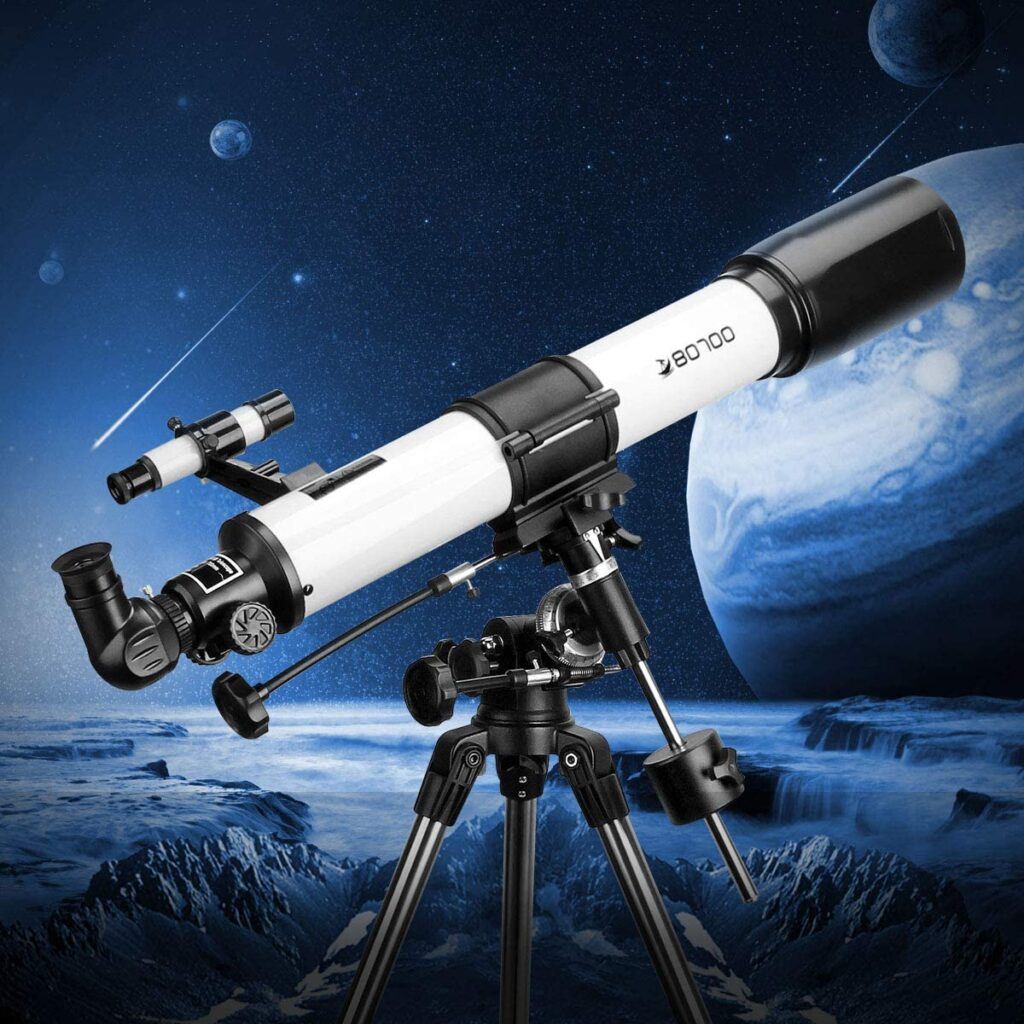
The SOLOMARK 80EQ has a German equatorial mount with a slow-motion altitude rod for smooth and accurate pointing.
This study mount features large slow-motion control knobs so you can track objects smoothly and seamlessly across the night sky.
The telescope’s 13%T Moon filter can effectively prevent the interference of a large amount of reflected light, and observe the lunar craters more clearly.
This is also one of the best telescope for iPhone astrophotography as it comes with a phone mount and a smartphone adapter.
a 90°prism diagonal provides an upright image, you can view the erect image and just look down with a comfortable angle, solve the trouble of inverting the image.
Pros:
- Portable
- Great optics for the price
- Comes with a moon filter
- Perfect for smartphone photography
- Lightweight and easy to setup
- Great telescope for the whole family
Cons:
Mount is a bit flimsy
Best With Equatorial Mount
Celestron – PowerSeeker 80EQ
- Aperture: 80 mm (3.15″)
- Focal length: 900mm
- Focal Ratio: f/11
- Mount: Equatorial
- Eyepiece: 20mm, 4mm
- Magnification: 45x, 225x
- Weight: 16.38 lbs (7.4 kg)
- Our Rating: 9/10
Prices pulled from the Amazon Product Advertising API on:
Product prices and availability are accurate as of the date/time indicated and are subject to change. Any price and availability information displayed on [relevant Amazon Site(s), as applicable] at the time of purchase will apply to the purchase of this product.
The 70EQ Power Seeker is a refractor telescope with a 80mm aperture and a focal length of 900mm. Its low price combined with excellent optics, easy assembly, clear instructions, included eyepieces and other features that make it easy to use even for beginners, make it an excellent choice for anyone wanting to learn more about the nighttime sky.
At f/11, there is some chromatic aberration but nothing significant enough to ruin high-power views with this telescope. The optical quality of the Powerseeker 70 is quite good.
The scope’s focuser is a 1.25” rack-and-pinion made mostly of plastic. The focuser even includes a tension adjustment knob, should you find the focuser to be too loose or too tight.
Since Celestron PowerSeeker 80EQ telescope is a family-friendly scope, it is very easy to set up and use as it needs no extra tools. The instructions manual clearly describes every setup step, giving clear information on each of the telescope’s parts and uses.
With an aperture of 80 mm (3.15″) and a focal length of 900 mm (35″), the Celestron Power Seeker telescope allows stargazers to see the Moon, Jupiter, Saturn and other celestial wonders with ease.
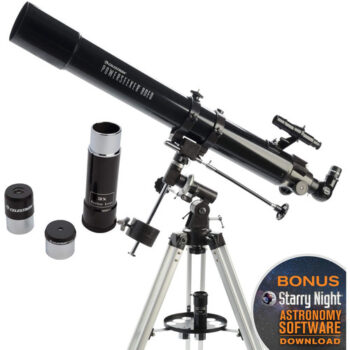
The 3x Barlow lens manages to triple the magnifying power of all eyepieces, while the 1.25″ Erect Image Diagonal makes the telescope ideal for both astronomical and terrestrial use.
The telescope includes fully coated optics, meaning that at least one lens in the telescope has been coated with multiple layers of substances designed to capture and focus the light that goes through the lens.
The equatorial mount supplied with the 80EQ is actually a good match for it. The motions are reasonably smooth, the mount’s extruded aluminum legs are quite steady with such a lightweight tube. Furthermore, the whole setup is pretty light at about 16 pounds.
The 80EQ PowerSeeker is the best beginner’s refractor telescope for astrophotography as it comes with a camera attachment that allows the user to take photographs of the objects being viewed.
Pros:
- Family-friendly, easy to setup and use
- Coated glass, decent optical components
- EQ mount with slow motion controls
- Budget option refractor telescope for astrophotography
- High and low power eyepieces
- Ideal for both terrestrial and celestial viewing
Cons:
- Not suitable for professional use
- Most components are built with plastic
Related
Best Refractor For Kids
Stilnend Telescope
- Type: Refractor
- Aperture: 70mm (2.75″)
- Focal length: 500mm
- Mount: Alt-az
- Eyepiece: 10mm, 25mm
- 3x Barlow lens
- Magnification: 15x, 50x
- Weight: 5.34lb (2.42kg)
- Our Rating: 7/10
Prices pulled from the Amazon Product Advertising API on:
Product prices and availability are accurate as of the date/time indicated and are subject to change. Any price and availability information displayed on [relevant Amazon Site(s), as applicable] at the time of purchase will apply to the purchase of this product.
The Stilnend 70mm telescope is an amazing telescope for a budding astronomer who wants to take pictures of his/her celestial finds with an iphone or an android smartphone
This scope comes with two replaceable eyepieces along with a 3X Barlow lens. So, it makes sure that you get the best image quality and see the planets as well as stars in great detail.
Moreover, the telescope also provides you with a 5×24 finder scope which also has special cross-hairline markings.
Therefore, it allows you to easily find and locate different astronomical objects with the utmost precision.
The telescope comes bundled with a phone adapter which is easy to mount on the telescope and begin your astrophotography journey.
Most importantly, Stilnend ensures complete satisfaction. If you ever face any problem you can easily call them to get the issue resolved within 24 hours.
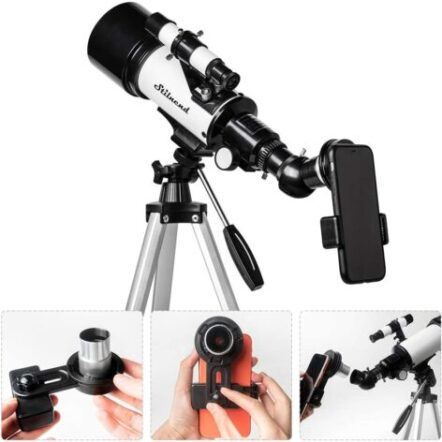
The telescope is a perfect Christmas or birthday gift for kids or beginner astronomers. It helps them build interest in astronomy and science, exploring the unknown, enjoying nature and away from screens. The kids’ astronomical journey may as well start with this amazing beginners telescope.
This is a perfect travel telescope and it also allows for many different viewing positions with an adjustable aluminum alloy tripod and a carry ba. The telescope and tripod can fit inside the bag for easy traveling to your favorite viewing spot and take great images with your cell phone.
Pros:
- Perfect grab-and-go telescope
- Great smartphone astrophotography telescope
- Easy to setup and use
- Good optics for price
- Lightweight
Cons:
- Tripod is a bit shaky
Best With Alt-Azimuth Mount
Gskyer Telescope AZ90600
- Type: Refractor
- Aperture: 90mm(3.5”)
- Focal length: 600mm
- Focal Ratio: f/6.7
- Mount: Altazimuth Mount
- Eyepiece: 25mm,10mm,5mm
- Magnification: 24x, 60x, 120x
- Weight: 18 lbs. / 8.2 kg
- Our Rating: 9.2/10
Prices pulled from the Amazon Product Advertising API on:
Product prices and availability are accurate as of the date/time indicated and are subject to change. Any price and availability information displayed on [relevant Amazon Site(s), as applicable] at the time of purchase will apply to the purchase of this product.
Gskyer is a German company and is one of the best telescope brands in the world, known to produce high-quality telescopes.
This is a great starter telescope for the explorer who intends to take their telescope with them on their journeys. Hiking, camping, and even moonlit fishing trips will be more fun when you have this telescope along with you.
The Gskyer AZ90600 is one of the best refractor telescopes for the money. If you live in the city and you aren’t able to see much of the sky due to light pollution, you’ll want a telescope like this that’s easy to carry with you.
The 90 millimeter aperture is perfect for viewing most of the things you’d want to view, and all of the glass optics are coated to automatically adjust the brightness of the stars to a level safe and comfortable for observation.
Though this is a beginner telescope, you can use it to observe the moon, stars, meteors, and planets. The telescope offers great clarity, allowing you to see the surface of the moon, the rings of Saturn and the moons of Jupiter.
It also comes with a smartphone adapter, which allows you to use the phone as a screen, or as a camera to take great pictures.
Plus, this model is extremely easy to assemble and doesn’t require any calibration. If you’re a telescope beginner, you won’t have to worry about any tricky steps or complicated tests.
The Gskyer AZ90600 comes with an adjustable tripod. This adjustable aluminium tripod offers the viewer many different viewing positions. The height of the aluminum tripod can be adjusted from about 31.5-inch to 49-inch.
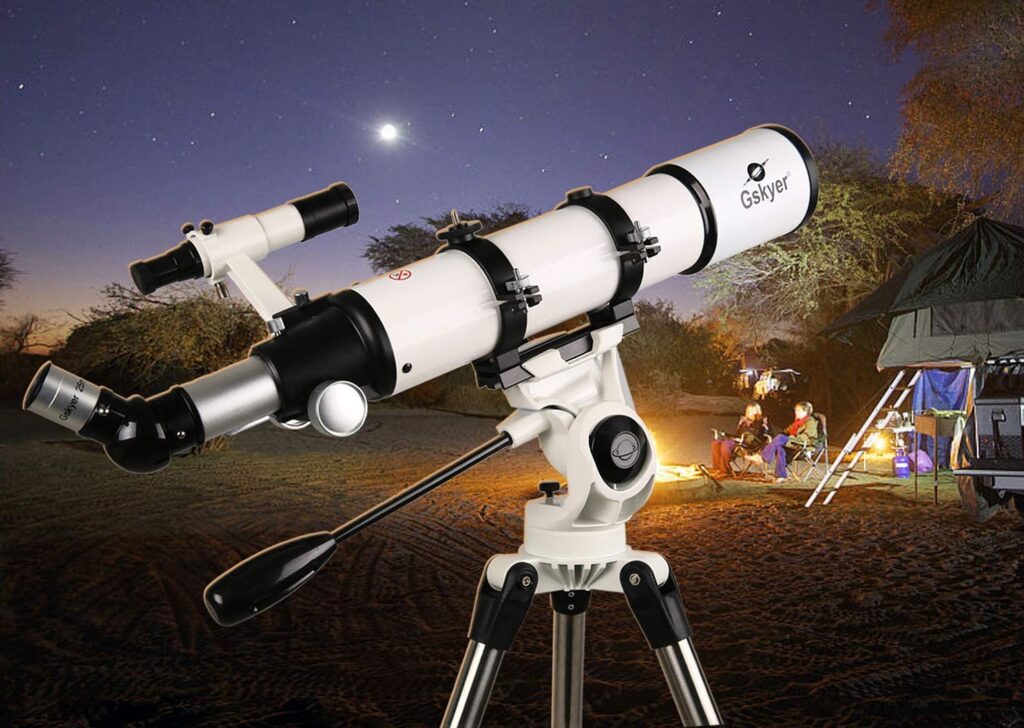
This is one of the best refractor telescope for beginners, it’s 90mm (3.5″) aperture gives bright, sharp images for both land and celestial objects.
Whether you’re viewing the rings of Saturn, the moons of Jupiter, surface details on the Moon, or terrestrial objects, the Infinity 90 Refractor allows the amateur astronomer to explore the solar system and beyond.
Pros:
- Large aperture
- 3 eyepieces
- Smartphone adapter
- Easy to assemble and use
- Adjustable tripod
- Perfect travel telescope
Cons:
- Good for viewing planets, stars not so much
Best 4″ Refractor AstroMaster 102AZ
- Aperture: 102mm (4″)
- Focal length: 660mm
- Focal Ratio: f/6.5
- Mount: Alt-az
- Eyepiece: 20mm, 10mm
- 2x Barlow lens
- Magnification: 33x, 66x
- Weight: 14.1 lbs. (6.4kg)
- Our Rating: 9/10
Prices pulled from the Amazon Product Advertising API on:
Product prices and availability are accurate as of the date/time indicated and are subject to change. Any price and availability information displayed on [relevant Amazon Site(s), as applicable] at the time of purchase will apply to the purchase of this product.
The Celestron – AstroMaster 102AZ Refractor Telescope is perfect for observers who want clear views of the Moon, planets, star clusters, galaxies and more.
This 102mm refractor telescope is extremely portable, meaning you can bring it with you on camping trips, hikes, and stargazing parties.
The instrument is of a perfect size if you are looking for a good entry-level telescope which is relatively lightweight and portable, but still has plenty of optical power for viewing deep sky objects.
The AstroMaster 102AZ is a refractor telescope that is well-constructed, resistant to shocks and bumps, sturdy and requires little maintenance.
This telescope is one of the best 4” refractor telescopes that you can buy.
It comes with two eyepieces; 20mm and 10mm eyepiece. This gives you adjustability as you can watch near and distant objects. A Red Dot Finderscope is also offered to allow you to track objects with great ease.
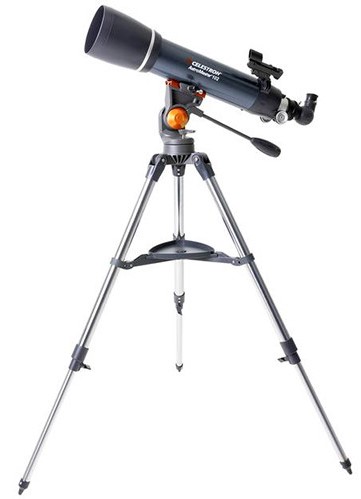
As a 4” refractor telescope, it is an ideal for deep sky astronomy. It provides clear images of the Ring of Saturn, Moons of Jupiter and thousands of craters of our Earth’s moon.
The altazimuth mount and the easy-to-use pan handle control gives you the freedom to follow the target of your choosing without losing any of the accuracy and clarity of the image you are inspecting through the telescope.
Celestron Star Diagonal is a 1.25″ 90° Erect Image Diagonal. Using this diagonal, you can enjoy daytime viewing as well. The diagonal will flip the image that the refractor inverts, making the sights right-side-up.
The model comes along with a lot of amazing accessories. For instance, the steel tripod is not only sturdy, but it is also adjustable to provide you with excellent viewing conditions. There is also an accessory tray that you can use to keep eyepieces etc. during a viewing session.
The scope includes a ‘Starry Night’ computer software which allows you to connect the telescope to a computer and track and plan your observations. As an added bonus you can access valuable information on 10,000 celestial objects.
Pros:
- Dual-purpose telescope suited for terrestrial views as well as astronomical use
- Fast and simple setup
- Rugged tripod with steel tube legs
- Astronomy software allows you to see up to 10,000 objects
- Erect image optics
Cons:
- Not for professional use
- Not good for astrophotography
Best For Android Astrophotography
Gskyer Telescope, 70mm
- Type: Refractor
- Aperture: 70mm (2.75″)
- Focal length: 400mm
- Focal Ratio: f/5.7
- Mount: Alt-Azimuth
- Eyepiece: 25mm, 10mm
- Magnification: 16x, 40x
- Weight: 5.3 lbs.(2.4 kg)
- Our Rating: 9/10
Prices pulled from the Amazon Product Advertising API on:
Product prices and availability are accurate as of the date/time indicated and are subject to change. Any price and availability information displayed on [relevant Amazon Site(s), as applicable] at the time of purchase will apply to the purchase of this product.
The Gskyer’s AZ70400 Telescope is a 70mm aperture and 400mm short focal length refractor telescope mounted on a camera type tripod. It includes a 45 degree diagonal, a carry case, finder scope, two eyepieces, a 3x Barlow lens and a smartphone adapter which makes it one of the best beginner refractor telescope for iPhone/Android astrophotography.
The overall assembly of the telescope is straightforward and perfect for anyone with little to no prior knowledge.
The included 3x Barlow lens, 25mm, and 10mm eyepiece all offer varying levels of magnification. The maximum magnification is x120 and provides clear images of the moon, planets, and some star arrangements.
The telescope comes with an altazimuth mount screw tripod made of aluminum alloy for support and stability while viewing distant objects.
In addition, the telescope comes with a rack and pinion mechanism to assist the focuser in bringing distant objects closer for easy and detailed viewing. The slow motion lever enables you to track celestial objects in motion quite easily.
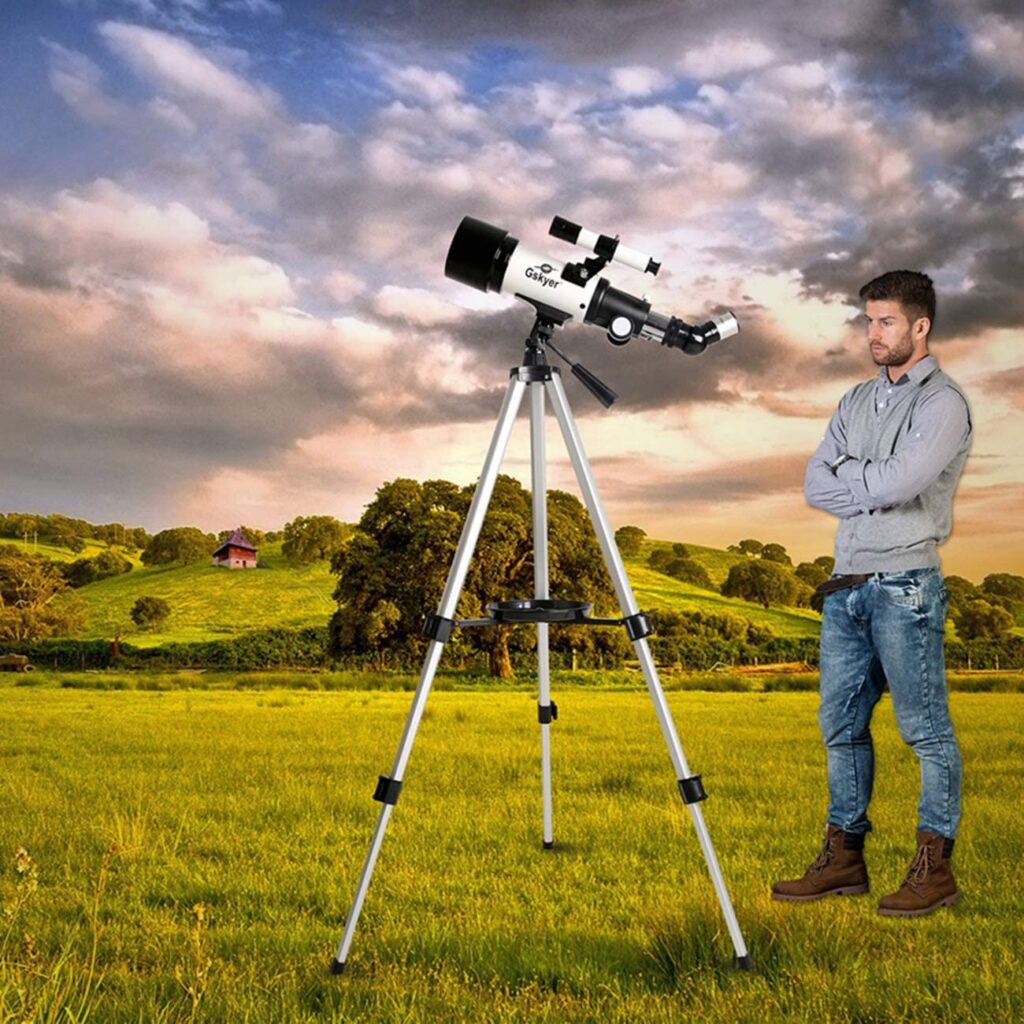
Setting up the scope typically takes anywhere from 15-30 minutes. Regardless of previous astronomical equipment experience, the step-by-step guide makes putting the telescope together quick and easy.
Because of its rugged design, this type of telescope provides reliable performance in the most demanding conditions so images are kept steady, with no interferences or reflections on the path of light.
Pros:
- Easy to setup and use
- Very portable
- Perfect for beginners and family
- Decent optics
- Comes with its own backpack
- Robust design
Cons:
- Instruction manual is a bit vague
- Difficult to collimate
Best Portable Option
Celestron – 70mm Travel Scope DX
- Aperture: 70mm (2.8″)
- Focal length: 400mm
- Focal Ratio: f/5.7
- Mount: Alt-Azimuth
- Eyepiece: 20 mm, 10 mm
- Magnification: 20x, 40x
- Weight: 3.3 lbs.(1.5 kg)
- Our Rating: 8.4/10
Prices pulled from the Amazon Product Advertising API on:
Product prices and availability are accurate as of the date/time indicated and are subject to change. Any price and availability information displayed on [relevant Amazon Site(s), as applicable] at the time of purchase will apply to the purchase of this product.
The Celestron 21035 70mm Scope is an excellent, easy-to-use, portable scope that comes with its own backpack and a variety of features.
The Travel Scope is a great choice for both beginners who are looking to start off their astronomical careers and for intermediate astronomers looking to refine their skills.
The scope comes with a 45 degree correct image diagonal, one 20mm and one 10mm eyepiece, a finder scope, a tripod, a lens cleaning cloth and an excellent instruction manual.
The 2.76 inch aperture is well-suited for the purpose of this portable telescope and provides bright and crisp views given its size.

The included eyepieces work very well in providing clear, crisp views of smaller objects. You’ll find it easy to get good looks at the details of the moon and you can even see the crevasses of the moons of Jupiter.
It even provides you the magnification you need to spot the terrestrial objects you’re looking for in the night sky.
The telescope also comes with Sky X software, which allows you to learn the basics of astronomy and how to use your new telescope. Sky X is a great addition to any telescope and is an excellent tool to help beginners.
If you are looking for a small refractor telescope with decent optics then the Celestron 70mm is a great option.
It is one of the best travel telescopes for beginners and has an excellent value as a portable telescope or a beginner’s telescope.
We highly recommend it for all beginner astronomers and especially for those who are always on the move with their telescopes.
The best features of Celestron 21035 70mm Travel Scope are its price and portability. Given the number of components, the price is extremely small. This is an excellent, easy-to-use, portable telescope.
Pros:
- Compact size makes the telescope highly portable
- Good value for money
- Decent optics
- Comes with its own backpack
- Good value for money
Cons:
- Wobbly tripod
- Finderscope and focuser are made of plastic
Best For Viewing The Moon
HUTACT Telescope
- Type: Refractor
- Aperture: 70mm (2.75″)
- Focal length: 400mm
- Eyepiece: 6mm, 25mm
- Magnification: 16x, 67x
Prices pulled from the Amazon Product Advertising API on:
Product prices and availability are accurate as of the date/time indicated and are subject to change. Any price and availability information displayed on [relevant Amazon Site(s), as applicable] at the time of purchase will apply to the purchase of this product.
This astronomical telescope is one of the best refractor telescope for terrestrial viewing as it can be used to observe planets, constellations, nebulae and stars in the sky, as well as birds, landscapes, animals, plants, etc. on land.
Its 70mm large diameter contrast 50mm small caliber, with efficient light collection, higher resolution, clearer imaging and higher color reproduction, lets you have perfect visual enjoyment.
The telescope has a stable tripod and the height and angle can be adjusted according to changes in the moon. In addition, the wired phone controller is more stable than Bluetooth control and will not miss any scenery you want to record.
The telescope is easy to install and disassemble and has a folding design which makes it one of the best grab and go refractor telescope for beginners.
This telescope guarantees great quality as it comes with a one month refund and a lifetime warranty.
Pros:
- Great for night sky and terrestrial viewing
- Comes with a wired phone controller
- Lightweight and easy to carry
- Good amount of accessories
Cons:
Not for professionals
Best Travel Pick
Orion GoScope III 70mm
- Type: Refractor
- Aperture: 70mm(2.75″)
- Focal length: 400mm
- Focal Ratio: f/5.7
- Mount: Altazimuth
- Eyepiece: 25mm, 9mm
- Magnification: 16x, 40x
- Weight: 3.5 lb / 1.6 kg
- Our Rating: 9/10
Prices pulled from the Amazon Product Advertising API on:
Product prices and availability are accurate as of the date/time indicated and are subject to change. Any price and availability information displayed on [relevant Amazon Site(s), as applicable] at the time of purchase will apply to the purchase of this product.
The Orion GoScope III 70mm Refractor Travel Telescope Moon Kit is a specifically designed telescope for advanced moon viewings from one of the best telescope brands for beginners in the world.
The affordable Orion GoScope III 70mm Refractor Travel Telescope features a 70mm achromatic lens system for sharp images of distant subjects.
This provides high quality, crisp and sharp images of distant objects. The resulting images are far better than other telescopes in this price range.
This 400mm focal length telescope (f/5.7) is perfect for daytime birding use as well as viewing wildlife, scenery and nighttime observing of the Moon and bright planets with the entire family.
The telescope includes 5×24 finder scope and two 1.25″ telescope eyepieces (25mm and 9mm) for 16x and 40x magnification.
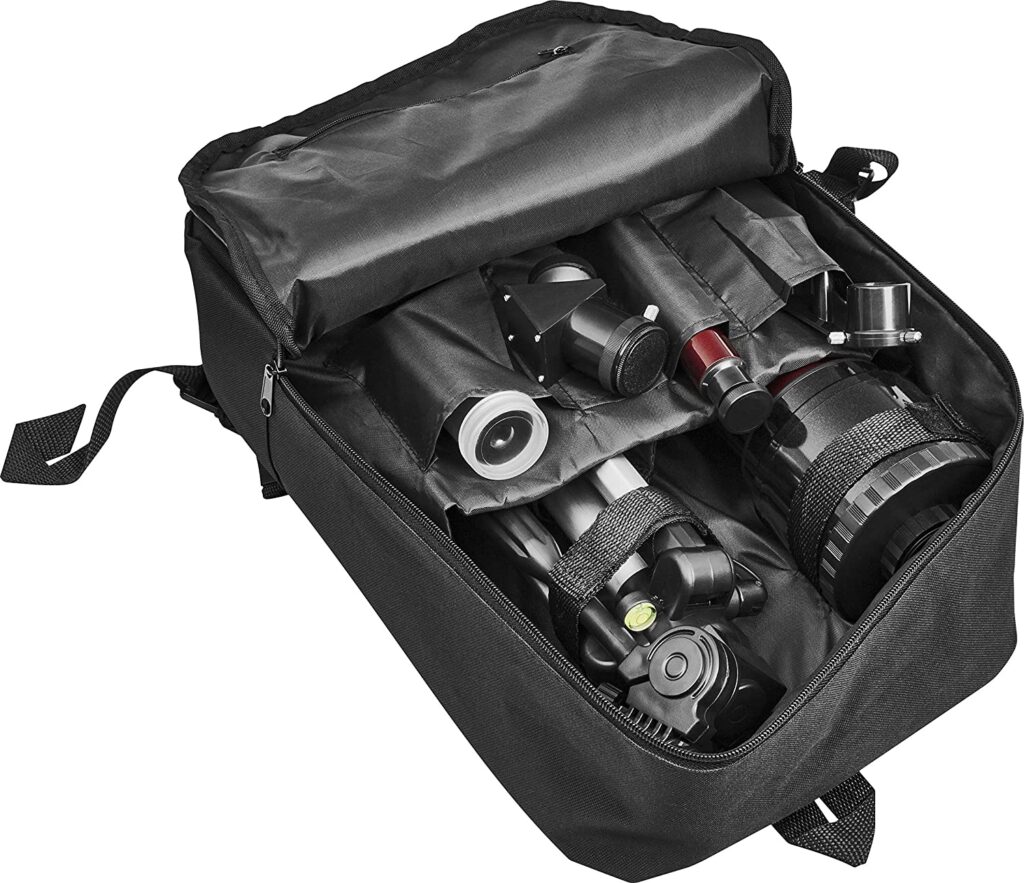
It also comes with the Orion MoonMap 260 which helps you and your family learn more about the Moon and it’s surface.
Its light weight of just 3.5 lbs. makes it easy for kids and beginners to take the telescope anywhere.
Is is most certainly one of the best refractor telescope for beginners if you are interested in observing the moon from your backyard.
The telescope and its aluminum tripod can be easily stored and carried to your favorite observing location in it’s included backpack.
The Orion GoScope Refractor Travel Telescope is one of the best small travel telescopes for in regards to value for money, and is a great tool for travelling and outdoors activities. It’s light, easy to use and doesn’t require extensive knowledge of either telescopes or astronomy.
You will find a lot of uses for the respectable optics of the Orion GoScope III 70mm Refractor Travel Telescope, and a lot of times and places to use them, day or night.
Pros:
- Lightweight aluminum tripod for beginners and families on the go
- Rugged and robust, hence will last you a long time
- Good value for money
- Decent optics for the price
Cons:
- Does Not come with instruction manual
- Not suitable for professional use
Best For Amateurs
Celestron – AstroMaster 90AZ
- Aperture: 90mm (3.54″)
- Focal length: 1000 mm
- Focal Ratio: f/11
- Mount: Alt-az
- Eyepiece: 20mm, 10mm
- Magnification: 50x, 100x
- Weight: 20 lbs.(9.1 kg)
- Our Rating: 9.4/10
Prices pulled from the Amazon Product Advertising API on:
Product prices and availability are accurate as of the date/time indicated and are subject to change. Any price and availability information displayed on [relevant Amazon Site(s), as applicable] at the time of purchase will apply to the purchase of this product.
The Celestron AstroMaster 90AZ altazimuth refractor is a perfect choice for a beginner who is looking to buy their first telescope to venture into astronomy and enjoy the night sky.
This reasonably priced 90 mm aperture refractor optical system is a good way to begin your journey into the night sky, as well as exploring nature during the day.
It provides you with detailed high-contrast views of the Moon and planets in the heavens, as well as sharp views of birds and animals across a lake or across the way.
For the astronomy enthusiast whose interests are the brighter solar system and deep space objects, the AstroMaster 90AZ has a lot to offer.
Its 3.5″ aperture has a light grasp 165 times that of the sharpest eye for nighttime use. Its large aperture and diffraction-free images make it surprisingly good for much deep space observing.
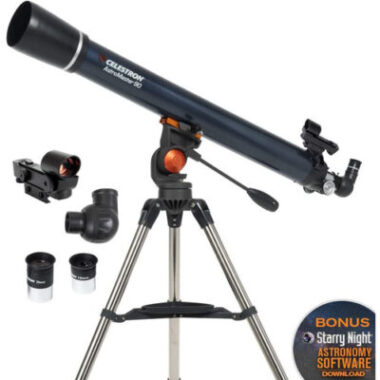
This version of the AstroMaster comes with two eyepieces (Sirius Plossl 20 mm,10 mm) that yield low and medium magnifications, and a 90° diagonal that sports an integrated erecting prism to correct images and allow the scope to be used as a conventional spotting scope for terrestrial use.
When used for astronomical viewing, the AstroMaster 90AZ yields breathtaking views of the Moon, Saturn with its ring structure, Jupiter and its belts and moons, nebulae, and star clusters.
The telescope features all-glass optical elements as well as smooth-operating steel tripod mountings featuring manual motion controls.
Additionally, the optics are coated for enhanced image brightness and clarity.
Upon its purchase, you can also download Celestron’s Starry Night Software and learn about the night sky, celestial objects, and plan your next stargazing session.
Pros:
- Great optics
- Great images of the moon and planets as well as terrestrial images
- Perfect for beginners as their first telescope
- Stable tripod
Cons:
- Finderscope could be better
How Does a Refracting Telescope Work
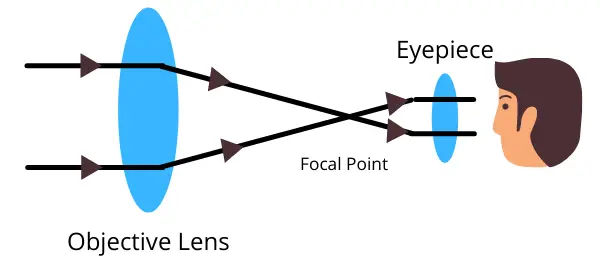
While they were invented in 1608, Galileo was the first to introduce his version to the public in 1609, so he’s credited with a version called the Galilean telescope. It used a convergent objective lens and a divergent eyepiece to get an upright image.
The refracting telescope bends light with lenses. That’s the basic way that the refractor works, but there’s obviously more to it than that. There are two lenses in the refractor telescope. One is at the end of the tube while the other is in the eyepiece.
The large lens at the end of the tube brings light into the tube. This is the objective lens. It’ll create a real image of the object being studied. In the tube, the real image is formed.
The magnification happens in the eyepiece lens. That lens takes the real image and magnifies it for your viewing.
Advantages Of Refractor Telescope
- Have simple design that ensures ease of use and high reliability.
- Do not require much maintenance and collimation.
- Closed optical tube assembly – the interior is protected from dust and air currents that adversely affect image quality.
- Quick thermal stabilization compared to reflectors and catadioptric designs.
- Excellent for observations of the Moon, Solar System planets, double stars (especially large aperture refractors).
- Maximum image contrast due to the absence of effect of the central screening by the secondary or diagonal mirror.
- Good color rendering properties in achromatic and excellent in apochromatic schemes.
- Can be used for terrestrial viewing.
Disadvantages Of Refractor Telescope
- All refractors suffer from an effect called chromatic aberration (“color deviation or distortion”) that produces a rainbow of colors around the image. Because of the wave nature of light, the longer wavelength light (redder colors) is bent less than the shorter wavelength light (bluer colors) as it passes through the lens. This is used in prisms to produce pretty rainbows, but can it ruin an image.
- Higher cost per inch of aperture compared to reflectors or catadioptric telescopes;
- As a rule, larger weight and dimensions compared to reflectors and catadioptric telescopes of the same aperture;
- High cost and bulkiness of construction imply limitations on the aperture size;
- Generally less suitable for observations of small and faint deep-sky objects due to practical limitations in the size of the aperture.
Conclusion
We hope that our guide helped you find the best refractor telescope for beginners.
Entry-level refracting telescopes are ideal for children and all beginning explorers of the skies. They are lightweight, compact, easy to use and maintain, and don’t require any collimation requiring special skills and knowledge.
High-end apochromatic refractors are great for professional observers as they provide quality views with no effect of chromatic aberration. That makes them ideal instruments for both visual observations and astrophotography.
Choosing a good beginners telescope is not an easy task – if you have any hesitation on what telescope type will be the best for your needs, but you can surely purchase any one of the refractor telescopes that we have reviewed in this article.
ABOUT US
We are a team of active amateur astronomers, here to help you with all your astronomy and science related needs – this is anything, from reviewing the latest telescopes to be released to talking about gravity and neurons. The Big Bang Optics was started because of our love for astronomy and to help others like us find the best telescope and accessories.
LEGAL DISCLAIMER
The Big Bang Optics is a participant in the Amazon Services LLC Associates Program, an affiliate advertising program designed to provide a means for sites to earn advertising fees by advertising and linking to Amazon.com. The Big Bang Optics also participates in affiliate programs with Clickbank and other sites. The Big Bang Optics is compensated for referring traffic and business to these companies.


